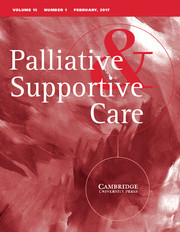Guest Editorial
Survival of the fittest … caregiver?
-
- Published online by Cambridge University Press:
- 23 January 2017, pp. 1-2
-
- Article
-
- You have access
- HTML
- Export citation
Original Articles
Validation of a model of family caregiver communication types and related caregiver outcomes
-
- Published online by Cambridge University Press:
- 01 April 2016, pp. 3-11
-
- Article
- Export citation
Patient and caregiver characteristics related to completion of advance directives in terminally ill patients
-
- Published online by Cambridge University Press:
- 30 May 2016, pp. 12-19
-
- Article
- Export citation
The needs of siblings of children with a life-threatening illness, part 2: Psychometric validation of the IBesFEMS
-
- Published online by Cambridge University Press:
- 27 May 2016, pp. 20-31
-
- Article
- Export citation
Identifying and addressing the support needs of family caregivers of people with motor neurone disease using the Carer Support Needs Assessment Tool
-
- Published online by Cambridge University Press:
- 13 May 2016, pp. 32-43
-
- Article
-
- You have access
- HTML
- Export citation
“There were more decisions and more options than just yes or no”: Evaluating a decision aid for advanced cancer patients and their family caregivers
-
- Published online by Cambridge University Press:
- 12 August 2016, pp. 44-56
-
- Article
- Export citation
Development of the Bereavement Risk Inventory and Screening Questionnaire (BRISQ): Item generation and expert panel feedback
-
- Published online by Cambridge University Press:
- 12 August 2016, pp. 57-66
-
- Article
-
- You have access
- HTML
- Export citation
The Views of Informal Carers' Evaluation of Services (VOICES): Toward an adaptation for the New Zealand bicultural context
-
- Published online by Cambridge University Press:
- 11 April 2016, pp. 67-76
-
- Article
- Export citation
End-of-life care decisions using a Korean advance directive among cancer patient–caregiver dyads
-
- Published online by Cambridge University Press:
- 02 November 2016, pp. 77-87
-
- Article
- Export citation
Parents with cancer: Searching for the right balance between telling the truth and protecting children
-
- Published online by Cambridge University Press:
- 21 June 2016, pp. 88-97
-
- Article
- Export citation
Enhancing psychosocial and spiritual palliative care: Four-year results of the program of comprehensive care for people with advanced illnesses and their families in Spain
-
- Published online by Cambridge University Press:
- 07 November 2016, pp. 98-109
-
- Article
- Export citation
Review Article
A systematic review of instruments assessing dimensions of distress among caregivers of adult and pediatric cancer patients
-
- Published online by Cambridge University Press:
- 29 March 2016, pp. 110-124
-
- Article
-
- You have access
- HTML
- Export citation
Sleep disturbances in caregivers of patients with advanced cancer: A systematic review.
-
- Published online by Cambridge University Press:
- 18 January 2017, pp. 125-140
-
- Article
- Export citation
Essays/Personal Reflections
Supporting a loved one living with motor neurone disease
-
- Published online by Cambridge University Press:
- 08 April 2016, pp. 141-142
-
- Article
- Export citation
The after effects of a mother's loss
-
- Published online by Cambridge University Press:
- 21 June 2016, pp. 143-145
-
- Article
- Export citation
Front Cover (OFC, IFC) and matter
PAX volume 15 issue 1 Cover and Front matter
-
- Published online by Cambridge University Press:
- 07 February 2017, pp. f1-f2
-
- Article
-
- You have access
- Export citation
Back Cover (IBC, OBC) and matter
PAX volume 15 issue 1 Cover and Back matter
-
- Published online by Cambridge University Press:
- 07 February 2017, pp. b1-b2
-
- Article
-
- You have access
- Export citation



